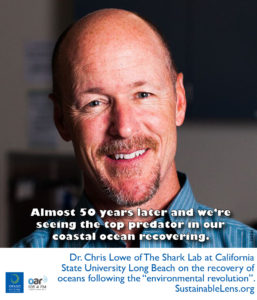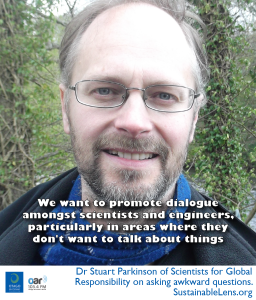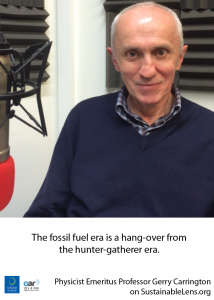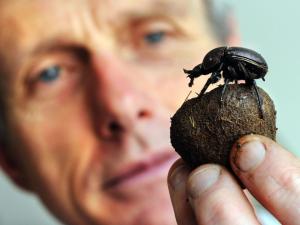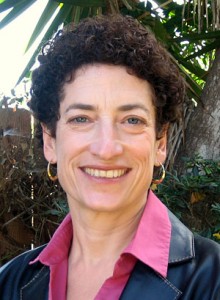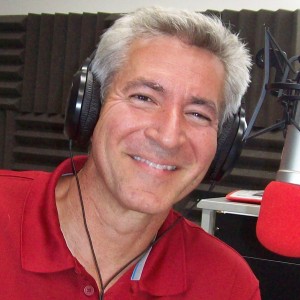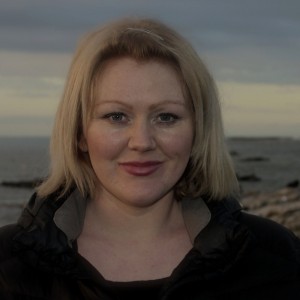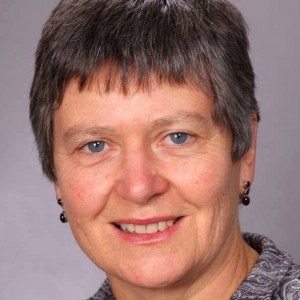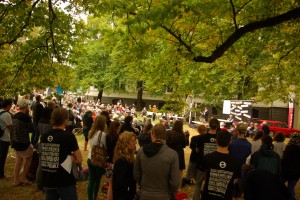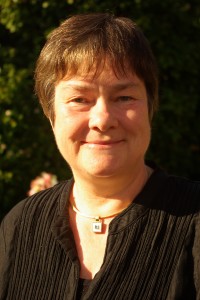| Sam: |
Welcome to Sustainable Lens, Resilience on Radio. A weekly show on sustainability topics brought to you by Otago Polytechnic. The show is co-hosted by Shane Gallagher, and me, Samuel Mann. Shane’s not here tonight because I’m at the California State University of Long Beach. There’s big signs up everywhere that just say The Beach. So we’re at the beach.
|
|
Each week we talk with someone making a positive difference, and we try to find out what motivates them, what it means to see the world through a sustainable perspective through their sustainable lens. Tonight’s sustainable lens, appropriately for the beach, is that of Dr. Chris Lowe, Professor of Marine Biology and Director of the Shark Lab here at California State University Long Beach. Thank you very much for joining me.
|
| Chris: |
Sure. It’s a pleasure.
|
| Sam: |
Big picture things first. Where’d you grow up?
|
| Chris: |
I grew up in Martha’s Vineyard, a little island off Cape Cod. My mom’s family had been on the Vineyard for a couple hundred years. We were whalers and sea captains and commercial fishermen and things like that. So I grew up fishing. Something I did everyday as a kid. I loved it. Then I learned to dive. First in my family to go to college, and they couldn’t understand why I wanted to be this strange animal called a marine biologist. Why didn’t I want to be a fisherman or a carpenter or something? I kind of broke the mould. I was the black sheep of the family.
|
| Sam: |
Did you always want to be a marine biologist?
|
| Chris: |
Probably since I was about eight. I really … I just found marine animals fascinating, and I just love learning about them.
|
| Sam: |
Where’d that come from?
|
| Chris: |
You know, I think it was I was just naturally drawn to them. I was fascinated by them. I would catch these different fish. I remember the first shark I caught. I was eight. I didn’t know what it was, and it actually forced me to go to this place called a library. I wasn’t a big reader, but that actually got me interested in reading. I spent a lot of time in the library learning about sharks, and that was it. I kind of knew what I was going to do, even though I didn’t know what that was and nobody in my family could tell me what it was.
|
| Sam: |
Did you have a mentor or somebody that inspired you on that?
|
| Chris: |
You know, I did. We had a shellfish hatchery on the island, and I met one of the marine biologists that was running that. He kind of took me under his wing and kind of got me interested in marine biology, and that was my first kind of mentor as somebody who did this for a living.
|
| Sam: |
So you took yourself off to college.
|
| Chris: |
Yeah, so I got a Bachelor’s degree in Marine Biology at a place called Barrington College, which was in Rhode Island. Then that led me to Central America, where I worked for a couple years building field stations. Then I came to Cal State Long Beach, actually, for my Master’s degree to work with a guy named Don Nelson. He was kind of a world pioneer in shark behaviour, and he started the Shark Lab here at Cal State Long Beach back in 1969. Don used a lot of technology, I’ve always been a technology fanatic, and he used a lot of technology to study sharks. A lot of the technology that’s used all around the world today was developed here at Cal State Long Beach.
|
| Sam: |
When you went off to do your B.S. in Marine Biology, is marine biology like studying everything but underwater?
|
| Chris: |
It was and that was good because what it did was it gave me a big broad perspective. I was learning about algae and invertebrates and all these things that weren’t necessarily my favourite, but I still found them interesting, and it gave me that kind of breadth. I had a better understanding of what sharks eat, for example. I think that was very important, part of my early career, was to have such a broad base in the study of all those different things.
|
| Sam: |
What did you enjoy the most?
|
| Chris: |
You know, we did a lot of salt marsh work, and I love slugging around the mud and doing beach transects and things like that. Even though I wasn’t working with sharks, I still loved that part. We were out in the field a lot, and that was the part that really kind of got me going. It even got me interested in things like chemistry and math and all the things that I didn’t think were important in marine biology, I learned to appreciate more.
|
| Sam: |
You’re still doing a lot of field work?
|
| Chris: |
I do.
|
| Sam: |
There’s a group of students behind you cleaning off the boat. You’ve been out recently.
|
| Chris: |
They’re getting ready.
|
| Sam: |
Oh, are they?
|
| Chris: |
We’re preparing for our summer field season, and they’re getting the boat ready to go. They’ll spend a whole summer living out at Catalina Island working on orange sharks and game fish and things like that.
|
| Sam: |
What’s the question for this summer’s work?
|
| Chris: |
Well, we have about eight projects running this summer, so that group that’ll be out at Catalina will be tracking horn sharks, which are kind of like Port Jackson sharks in Australia. Cute little sharks. They feed on things like sea urchins and crabs, and we believe they’re actually a keystone species for the kelp beds. I have a grad student who’s going to be using new devices we call Smart Tags that we clamp on their dorsal fin. It’s like a backpack that we put on their dorsal fin. It measures acceleration in three dimensions, and it has a gyroscope so we get a compass heading. We get a temperature and a depth that they’re at, and we can then put a transmitter on them and then follow them around and see where they go.
|
|
One of my grad students has been calibrating the Smart Tag in the lab by feeding sharks different types of meals, and we can actually identify what they’re eating based on their movement signatures.
|
| Sam: |
How they’re wiggling?
|
| Chris: |
Yeah.
|
| Sam: |
Swimming differently or something.
|
| Chris: |
Well, when they’re feeding. For example, when a horn shark eats a sea urchin, what it does is it has to pull all the spines off the sea urchin in order to get to the shell. When they do that, they get a lot of up and down, bouncy movements. So we can tell when they’re eating an urchin because they do that up and down, bouncy thing. But when they’re eating a crab, that becomes minimal, and it’s more side to side. We can begin to tease out those signatures and identify what they’re eating, so the goal would be in the field, we won’t have video cameras and somebody watching, but we can use the acceleration signals to figure out what are they doing during the day? What are they eating at night?
|
| Sam: |
Do you have a pile of students frantically getting equipment ready at the moment?
|
| Chris: |
I do.
|
| Sam: |
Testing a lot of gear that’s not behaving.
|
| Chris: |
Exactly. We’re getting ready for field season because we’re coming into the season when all the fish are going to be active. Our waters are going to start warming up. Productivity blooms in the spring. This is a big time of year for us, and summer is our big field season. In addition, we have a lot of fishers, just recreational fishers, that volunteer for us. They love it because they get to fish in a marine-protected area. But the coolest thing is we share the data with them. So they get to see not only all these big fish that they normally wouldn’t get to catch because it’s protected, but they’re involved in the science. They get to see how we collect the data and begin to understand why we do what we do, and they become awesome ambassadors because they go out and fish with their buddies, who are fishing in non-protected areas, and they tell them about the things that we’re finding. That’s how we’re changing, hopefully, the way fishing is done in southern California.
|
| Sam: |
In terms of the big question, the really big one: why sharks?
|
| Chris: |
I think a lot of it has to go back to when I was a kid. That fascination of seeing that animal that looked different than every other fish that I’d caught and not knowing what it was. Then really digging in and learning more about them. The more I learned, the more I realised well they’re just a fish, but they’re a very different fish. That kind of set me off on this path. I’ve studied sharks and stingrays and skates and, basically, the whole gamut is interesting to me. Unfortunately, there’s no money to do shark research, and that’s where my love of fishing comes in because … There’s actually a lot more funding to study game fish, fish that people like to eat, or fish that people like to catch, so a lot of my research has focused around that.
|
|
Then also the fact that I grew up fishing. I love to fish. My family’s living came from fishing, and I want to see that continue.
|
| Sam: |
You probably hate this question but I’m going to ask it anyway. What’s been the ongoing impact of Jaws?
|
| Chris: |
That is a major one, right? I think it’s had some good impacts and some bad. The bad impacts, of course, are people are afraid of sharks. The good impacts are that people are interested in sharks. Jaws only transitioned into Discovery Channel Shark Week. When you think about it, there’s an entire network that was dedicated, originally, from programming about sharks. The entire Discovery Channel Network started with that. When you think about it, it’s pretty remarkable. I mean, there are tonnes of books out there on sharks and snakes and whales and dolphins and things like that, but how many have their own week of programming?
|
| Sam: |
Is it an irrational fear?
|
| Chris: |
I think so. I mean, much of my job is dedicated to providing people with science-based information about sharks to help convince them that they’re not thin, mindless, feeding machines that people have imagined them to be. That’s hard to overcome because mass media has contributed a lot to that. I’m in the process of writing a book for the general public talking about how what we’ve learned about sharks over the years, the science behind what we’ve learned about sharks, and a little bit about why I think people think the way they do about sharks. A lot of it comes back to how our brain works.
|
|
In the early days when we would have to go out and fend for ourselves, hunter/gatherers would encounter dangerous animals. Then sometimes they’d have to fend them off, sometimes people would be killed, but they’d come back and they would talk about these vicious animals they encountered. People who weren’t in the field, maybe people who were just hanging around the camp, would intently listen about these things, and these stories would be scary because this was a scary event. What happens is your brain gives you a little happy juice when those things happen. That’s why people go to horror flicks because they get off on a little bit of being scared. But evolutionarily, it’s good for us to be scared. You remember those things. You paint that picture in your head. The tough part now is for us to convert that image that people have in their heads that have come from that scary stories and begin to give them some reality.
|
|
The other thing is, people are not aquatic. We don’t feel at home in the aquatic environment because we’re not aquatic, which adds another layer of fright to it. I can relate it back to wolves or bears or mountain lions. 150 years ago, we killed all those animals. We saw them as potential threats. They worried us. Sometimes they hurt people. They killed people, so we killed them. We’ve eliminated all the land predators. About 25, 30 years ago, we realised that that was not a good idea because ecologically, all the things they fed on were no longer being controlled. Like deer on the east coast. We’ve spent a lot of time and money bringing those things back, and a lot of that’s required science to learn more about wolves and their behaviours. That information’s got out into the public. The cool thing is, if I were to take the average person out and we were to go walking through Yellowstone and we were to see a wolf, and people were to see that, they would go, “Wow! That’s awesome! Look at that wolf!” If I were to ask, “Are you frightened right now,” they would go, “No because I learned all about wolves.”
|
|
Now the funny thing is, now imagine it’s night. It’s completely dark and I play back a wolf howl. Now they’ll know that’s a wolf, but if I ask them if they’re scared, they’ll go, “Yes.” If you ask why, they’ll go, “Well, I can’t see it.” Humans are very visual. We rely on our vision to reassure us. Here’s an example of an animal that most people will go, “I’ve learned a lot about wolves. They’re very caring. They’re group-oriented. They’re not potentially dangerous.” All those sorts of things. But that part of our brain that tells us I am no longer in control. I am no longer in my comfort zone. I’m at night. I’m not a nocturnal animal. I can’t see this animal coming. All of that programming changes. This is a difficult thing to convince people that sharks pose very little threat to them. It’s hard to get out of your head.
|
| Sam: |
I’m a distance ocean swimmer.
|
| Chris: |
Yeah.
|
| Sam: |
I swim along and the way to deal with it, is you just pretend it’s not happening.
|
| Chris: |
Exactly. But that’s hard to do, right? These are things that I think we’re making progress. Let me give you another good example. Whales. Okay, 100 years ago, 150 years ago, people were scared of whales. Whales were dangerous animals. They killed people. Now remember, most people never saw a whale, but whalers that would come back from these voyages where people would be killed by whales would talk about these horrible events where somebody was killed. They would paint these pictures. Now, you know the other part of the psychology is when somebody’s telling a story about something scary and people listen, they tend to embellish. What happened is these stories get scarier and scarier as time goes on. Moby-Dick, for example.
|
|
Okay, so by the end of the ’70s, most whales in most oceans had been hunted to the verge of extinction. Scientists are trying to do work on them. We’re trying to educate the public. Whales become protected in many coastal waters and many international waters. There was a lot of educating done about whales. What do we know about whales now? They’re mammals like us. They nurse their young. They’re highly intelligent. They’re very social. I think what really happened was whales got a very good PR agent back in the early ’70s, and they did a great job at changing people’s perspective about whales. Now, if we were to go out and somebody were to jump in the water and a whale to swim by, most people will go, “Oh, that’s a whale. That’s awesome!” They wouldn’t be scared at all.
|
|
How do we go from that with whales-
|
| Sam: |
At the same time, when sharks got a very bad PR agent, from their perspective.
|
| Chris: |
Exactly. So we’re in the process of rebranding.
|
| Sam: |
They’re also, for some cultures, tasty.
|
| Chris: |
That poses another problem. In many ways, that was a double whammy. People were afraid of them. They were scared of them, and they didn’t have a problem with fishermen catching them. In fact, they were doing double good. Not only are you eliminating threat, but you’re providing people with a meal. We quickly learned that this is where, one of those places, where sharks are different than other fish. So a shark and a tuna, two very different beasts. Tuna? 20 million eggs in a spawn. A shark may only produce one young every three years. How many tuna can you take before you completely deplete the population? By the way, that tuna can reach sexual maturity in two years. That shark may not reach sexual maturity until it’s 22-years-old.
|
| Sam: |
Which is a lot closer to mammalian type reproduction.
|
| Chris: |
They’re more like people. What we learned, literally in a 40- or 50-year period, very rapidly, is that you cannot fish sharks, rays, like we fish other fish. They’re more like people. They’re very easily over fished. When you do over fish them, it can take decades, or even a century, for their populations to come back. These are things that have been difficult to educate the public on mainly because of that fear. They saw that as a double good. You’re keeping the waters safe for us humans because you’ve eliminated the predators. Much like land predators, we have a lot of educating to do.
|
| Sam: |
Are they indicator species? Are they keystone species? Do they represent the health of the ecosystem?
|
| Chris: |
Well, most sharks are either intermediate or top predators, which means on the food pyramid, there are fewer of them. Their populations are most easily impacted, but they’re never very abundant. The top predators are usually the apex. The ones at the very, very tippy top are never super abundant because there’s never enough food to support them. So they’re easily impacted. White sharks are a good example of an apex predator that’s probably been impacted worldwide for over a hundred years. Now, there’s no direct commercial fishery for white sharks. There’s never been one. There’s been a recreational fishery, a trophy fishery for them here and there, but their numbers are so low that they could never support a commercial fishery.
|
|
Their teeth are incredibly valuable. Their jaws are valuable. Their fins. Their meat is perfectly edible and valuable, but they’re just not abundant enough to support that. Nonetheless, we saw their populations, what we think, go down from over fishing, mainly of the babies. A baby white shark is about a metre and a half long, about five feet long at birth. A female will give birth from anywhere to 2 to 14 sharks that size. One of the things that we’ve learned in the last 10 years is that a lot of these young white sharks like to hang out off our coastal beaches. Here in southern California, we have probably one of the largest nurseries for white sharks in the Northeast Pacific.
|
|
When I was a grad student here at Long Beach back in 1989, I never heard of that. We heard about adult white sharks up around the central California coast in the fall but never heard about a baby white shark ever. Then about 10 years ago, it started to happen. Fishermen started catching them on the piers. They’d catch them on the beaches. We’d get footage of people seeing them just literally right outside the wave break. Last year, we tagged 22 off Huntington Beach in a single summer. The numbers have just been going up and up and up.
|
|
What happened was this got me thinking about, “Okay, wait a minute. We’ve been telling the public that shark populations have been going down. How can this be? This doesn’t make any sense.” I didn’t believe my own data, so for a year, we collected more information, and we looked at more data, and we collected historic records, and the data all showed this trend of numbers going up. There were even other scientists who were saying, “No, the population’s going down.” We kept saying, “But this doesn’t match. You can’t have more babies without more mommies. Things have to be going up.” Then I started to ask questions. Well, how can the white shark population go up? Let’s just say, for example, that I’m right and the population is going up. How could that be?
|
|
Well, the white sharks have been protected in California for 20 years. In 1994, the state of California passed legislation to prohibit capture of white sharks. Mainly because they recognised the importance of white sharks in the ecosystem, and they recognised their vulnerability to over fishing. So for 20 years, they’ve been protected. There had been fishery interactions. Commercial fisheries have caught juvenile white sharks, and they landed them prior to 1994. But many of those commercial fisheries have gone away. They’ve either been banned, their use have been banned in certain locations, or the fisheries just went extinct because they couldn’t make a living anymore.
|
|
Just protection alone might have allowed some of the population to come back. However, that’s not enough to explain the trajectory that we saw. So what else does the population need to recover? Well, it needs food. So what do adult white sharks eat? They eat marine mammals. Then I started looking at marine mammal populations. Then is when the bells really started to go off. Our coastal seal and sea lion populations are some of the biggest carnivores we have in our coastal oceans. They’re warm-blooded like us, and they eat fish like gangbusters.
|
|
When you looked at their populations, to give you an example, in 1920 it was estimated that there were as few as 2,000 California sea lions in all of California and Baja. By 1920, they had been hunted to what biologists thought was the verge of extinction. If a fisherman saw a sea lion, they simply shot them. They viewed them as competitors. In 1973, the Marine Mammal Protection Act goes into place, and we see a steady uptake in California sea lion population. In the mid-1980s, there’s a dip. That dip was because of the last strong El Nino we had. Because the food got pushed offshore, a lot of sea lions starved. Then after that, in the mid-90s, when we heavily regulated commercial fishing in California, we see the greatest influction. Population was estimated to be growing at a rate of 6.5% per year at a time when we were telling the American public that we had fished out our ocean. We eat the same things sea lions eat, so if we fished out the ocean, how is this population growing at a rate of 6.5% per year?
|
|
Now population estimates for California sea lions are somewhere between 220,000 to 470,000 animals. They went from the verge of extinction to maybe the most that have ever been on the planet, in less than a hundred years. They did that because we protected them. Is it any surprise that the white shark population’s recovering if there’s all that adult white shark food out there? Now the question is, how does the sea lion population grow that fast? They need food, too. We’ve been telling the public … On the news, we hear about over fishing is a big problem and pollution is killing all the fish and we’re taking too many. How are they getting enough food? We’ve done a lot in the last 40 or 50 years to better manage our fisheries, to better manage our water quality.
|
|
In the US, we had what I call the Environmental Revolution, which occurred in the late ’60s. So Rachel Carson and all these other kind of alarm sounders about all this environmental damage that we had done through the US Industrial Revolution, which happened from the ’20s through the ’60s. As a result, we passed the US Clean Water Act, the Clean Air Act, the Wetlands Protection Act, the Magnuson-Stevens Act. In California, we passed the white shark protection. We banned the use of nearshore gill-nets. We passed the Marine Life Protection Act. We put in all this legislation because we recognised all those problems. Here we are 40, almost 50, years later, and we’re seeing the top predator in our coastal ocean recovering. I would argue that that is a sign that we’ve been doing some things right.
|
|
Now the interesting thing is, if you look in many of our coastal environments like southern California, we have 22 million people that live within 60 miles of the coastline. Every single one of those people flushes the toilet every day. All that water goes out five pipes. In the ’70s, California had the worst water quality that existed probably anywhere in the country. We were discharging raw sewage, basically, offshore. We had the industrial waste going into that wastewater treatment. Clean Water Act forced a massive restructuring of that. Now in southern California, we have complete secondary, in some cases tertiary, wastewater treatment. We have some of the best wastewater treatment that exists anywhere in the world, basically accommodating a huge population density. We have cleaner water now than we did fourty years ago, with three times more people.
|
| Sam: |
Is this a sign that southern California can be sustainable?
|
| Chris: |
I think so. I think so. I would argue that the steps to sustainability are recognising that there’s a problem, which is what has happened. People had to get disgusted with the air quality. People had to get fed up with the water quality. People had to be upset about over fishing. Enough so that it forces governments to do things. In addition, all those things, all that legislation comes at a cost. We, as citizens, pay taxes to cover those things. New technology has to be developed. That is a really important step to this process because the way you make water quality sustainable is you have to develop new technology to clean that water, to recycle that water, reuse that water. The only time that technology gets developed is when you have a problem.
|
|
I think the key in these steps are you recognise there’s a problem, people do something about it, and then we develop new technology that helps us remediate or deal with those problems.
|
| Sam: |
It seems like this is a good news story. We should be celebrating it. So why aren’t we? Is it, perhaps, there’s a fear that if we get it too right, the sharks will come back?
|
| Chris: |
Well-
|
| Sam: |
We’ll be afraid to go back in the water again?
|
| Chris: |
Well, yes and no. What I’ve been telling people is there are things that we should be definitely cheering about. We’ve solved a lot of problems and the recovery of that … Bringing back top predators is a sign that the ecosystem’s getting healthier. However, there are going to be challenges that come with that, and that is we’re going to interact with these animals more, and sometimes those are going to be negative interactions. The tricky part is, I would argue two generations of Americans have had the benefits of unfettered access to the ocean, to use it for all our recreation needs without worry of having to interact with those predators. But we’ve spent a lot of time and money trying to bring these animals back, and now that they’re coming back, we’re going to have to learn to share.
|
|
In my opinion, the way we do that is through education. People in many places have not learned to recognise and manage risk well. I think that’s particularly true in the United States. Okay, you go to Disney Land. You expect to be able to get on a ride and that ride will be safe. There are inspectors. There are all these strict codes that they have to adhere to to ensure that when you go there for fun and recreation, you will be safe in the park. When you go in the ocean, that disclaimer doesn’t hold true. That’s the part that people have forgotten. Even though we use the ocean for recreation, there are risks that we have to assume ourselves. Nobody else is responsible for those but ourselves.
|
|
When you go in the ocean, you could be bitten by a shark, but the likelihood is already so ridiculously low, that it is not worth worrying about. Nonetheless, you have the choice about whether you want to go in the water or not. Now if there are sharks sighted in that area, you have the choice as to whether you want to take that risk or not. I think what we need to do, and what I need to do as a scientist, is provide the best science-based information that we have about sharks and their behaviours to give people information so that they can make good, educated decisions on what they’re going to do and how they’re going to use the ocean.
|
| Sam: |
Is there media society interest in this too? There’s certainly the lots of interest in shark tourism and the people wanting to go and feed the sharks sort of stuff. Is there interest in the work you’re doing?
|
| Chris: |
I think there is. I think it’s growing. I think people’s attitudes towards sharks are changing, and I think the more science we use, the less fear. It’s like anything. The less you know about something, the easier it is to be afraid of it. The more you learn about it, the less you may fear it. One of my life’s goals are to provide the public with good science-based information about sharks to help alleviate those fears. The other thing is if people aren’t afraid of them, they’re going to care more about them, and therefore, they’re going to do more to protect them. I think we’re seeing that. In other words, I think what we’re seeing now with sharks is the same thing we saw with whales back in the ’70s and ’80s. We’re seeing a change in attitude where people are going from, “Kill them. They’re scary animals that could hurt me,” to “You can’t kill sharks. They’re important. We need to protect them.”
|
|
Unfortunately, that pendulum can go too far that way. To the point where people don’t think it’s right that a fisherman should be able to catch and eat a shark. They argue that shark fisheries aren’t sustainable, and that simply isn’t true, either. This is, again, where we have to use science to provide the public with the best information because we don’t want people wanting to protect animal fur for just those reasons that, “Oh, we needed to protect them 20 years ago, but now the populations are back. But we should still protect them.” In many ways, I think we should still be able to harvest and eat sharks, but we have to do it smartly. We have to do it sustainably.
|
| Sam: |
Do sharks have personalities?
|
| Chris: |
To a certain extent.
|
| Sam: |
You can tell them apart by how they behave?
|
| Chris: |
Yeah. In many ways, they’re not that different from people. You’ll meet people who you know who love to bike. That’s their favourite thing. If you give them all these different options of how to get around, they would prefer to bike, and they’re really good bikers. They’re good riders. They know how to ride well. They can ride in any conditions. They can mountain bike. They can street bike. We find very similar sorts of trends with sharks. There are some sharks that like to eat this one type of prey. If you watch them, they’ll feed primarily on that, and they’re really good at it. But they won’t eat other things, or other sharks may be more effective at eating those things and have learned to feed more effectively on a different prey. In that sense, we do start to see kind of trends or some people could call it a personality. But those sorts of things are common in sharks and other fish.
|
| Sam: |
Do they have complex societies?
|
| Chris: |
They do have pecking orders. They have clear pecking orders. They’re, to a certain degree, social, but I don’t think we fully understand all that. They do have networks. We have seen studies where some species will hang out together, individuals will hang out together, and they form, what could be, social groups. We don’t know about that just yet. You know males and females quite often separate at certain times of the year, and they occupy different habitats. The only time they come together is to mate. We’ve seen, what could be, cooperative hunting in some species. So there’s probably some of that, but not as much as we’d see in mammals, for example.
|
| Sam: |
When you have students come in, what are they wanting to do now? Is it that they’re people that, like you, think, “I’m going to study sharks. That’s what I’m going to do.” Or do people find their way here by accident, perhaps a mix of those things?
|
| Chris: |
A majority of the students that want to come work with me for grad school, that’s the primary thing they want to do. They want to study sharks. My wife, who’s a marine mammalogist, studies seals, and she argues that it used to be dolphins. Everybody wanted to become a marine biologist to study dolphins. Dolphins are out now; sharks are in. That’s part of that people losing that fear of sharks and wanting to know more about them and study them more. So that’s increasing.
|
|
I think the thing that I’ve noticed the most since being a professor, and looking back at my career, was my reason why I wanted to be a scientist was I wanted to learn about the animals. That generation that I was in, that’s what drove them to be scientists. This generation, if you were to ask them that big picture question, why do you want to be a scientist, why do you want to be a biologist, why do you want to be a marine biologist, and their answer is different. It’s “I want to protect things.” It’s amazing. This is a generational thing. Then I say, “Well, aren’t you just interested in learning,” and they go, “Well, of course, but we have problems to solve.” As an ecologist, it’s interesting for me to see that regime shift in philosophy. Why they want to be a marine biologist is to learn to conserve things.
|
| Sam: |
Does that mean you have to include policy and such that in your feature?
|
| Chris: |
Yeah. Absolutely. I teach a class in fisheries ecology in conservation, and the whole point of the class is to get them to understand that we have 8 billion people on the planet, and they all need to eat. Fish is an important food that we need to feed the masses with. Fishing isn’t going to go away just because some populations have been over fished. We still have to find ways of having fisheries, making them sustainable, and to do that, we need people who have good training and backgrounds. That might mean studying fisheries from different angles. What I mean by that is there are some people who are more interested in the beast, studying the fish and its ecology and its life history and its population dynamics. But there are another group, I call that group the more social group, who begin to understand when you regulate a fishery, you don’t regulate the fish; you regulate the people.
|
|
In order to do that, you need people who have good training in sociology, who have good training in psychology, who have good training in policy, and in regulations. Because you’re managing people, not a fish population.
|
| Sam: |
I’m thinking of the Maui’s dolphin in New Zealand, which seems to be on a relentless march to extinction, despite the obvious solution being stopping fishing in a couple of reasonably small areas.
|
| Chris: |
Right.
|
| Sam: |
Perhaps that’s not a wicked problem, but are there areas where you do have wicked problems? Those things that you just can’t untangle?
|
| Chris: |
Well, I think the biggest one, the biggest challenge … While I’m excited and I think what we’re seeing are signs that are really good here in California, and maybe in the US, the biggest one is global climate change. The problems that we have solved are regional problems. But global climate change, that’s different. That’s not the state of California saying, “We’re going to do this to try to reduce carbon emissions,” and those sorts of things. Or the US saying, “We’re going to do this,” or even a bunch of nations saying, “We’re going to get together and do this.” This is everybody on the planet pitching in to do something. That is hard. That is really hard. That’s going to take more than climate scientists. That’s going to take more than biologists and fisheries biologists. That’s going to take more than economists. That’s going to take everybody. I think that is a big, big problem.
|
| Sam: |
How sensitive are the sharks and other fish to climate change?
|
| Chris: |
Well, we’re trying to figure that out now. We’re already seeing shifts in populations that we are pretty convinced are attributed to these global climate change issues. Rising sea temperatures and things like that. But we don’t know exactly how those populations will be affected. They have the ability to move, so that automatically gives them a little bit of buffer. But other animals that can’t, like sessile invertebrates and things like that, they’re kind of screwed. But nonetheless, those are integral in the food chain, and somewhere along the line, they’re going to impact sharks. I see that as our biggest challenge now.
|
|
With the Maui’s dolphin, and here in California and Mexico, we had the Vaquita dolphin, where we have a limited area, the animals are definitely on the track for extinction. But you run into these challenges where you have these subsistence fisheries, you have these small scale artisanal fisheries, and you can’t shake your hand and say, “Oh, it’s the big industry that’s doing this.” You’re talking about people who are living on like $5,000 a year and putting them out of business. So we have to be more creative. We’ve done it in other places. We’ve done it at certain scales. The tricky part is quite often populations that are under these impacts, it’s more than just fishing that’s driving these issues.
|
|
I did a lot of work in Hawaii, and the Hawaiian monk seal is one of the most endangered marine mammals in US waters. However, it’s also one of the most isolated marine mammals. The Hawaiian Archipelago that they use is some of the most isolated areas in the entire planet, and yet its population is still declining even though humans have the least amount of interaction with that species. In some cases, you’ve got to wonder is it just evolutionary if the clock has run out on the species. We might have accelerated the clock a little bit, but their ticket was punched a while ago.
|
|
Now, the US government invests a lot of money in trying to keep that population going, but all the while, we have all these other populations that are really just getting hammered, but they’re not as charismatic as a seal. What do we do about those? Plants that are going extinct at unbelievable rates. But how do you get the public to rally around a plant? Or a toad?
|
| Sam: |
No. Most large animals have the advantage of being charismatic megafauna. Sharks don’t, perhaps, have the charismatic, but at least-
|
| Chris: |
Well, they do. They do. Maybe not as much as a dolphin or a whale.
|
| Sam: |
There was a cute one in Finding Nemo.
|
| Chris: |
Exactly. Whales, sharks, and things like that are … People can kind of rally around those species. But it’s all the others. What worries me is that there are a lot of conservation groups, there are a lot of NGOs, that will selectively pick those species because they know they can get funding for them. Yet, some of these other species are ignored. Who’s going to look out for those?
|
| Sam: |
Is there something that ordinary people can do, perhaps in their purchasing, that would help? Can we avoid shark fin [crosstalk 00:41:03]?
|
| Chris: |
Sure. In fact, I think this is the education component. We have to have multiple lines of defence when it comes to protecting species. We have to have federal protection. We have to have state protection. We have to get grass roots. We have to get people educated so that they understand why these regulations are in place and what they can do to minimise their impacts. Then after that, it’s really the consumer. The consumer has all the power. If people don’t buy a certain species of fish, or if they don’t buy shark fins, fishers won’t catch it.
|
|
Once we get past the marketability issue, then we have to get back to bycatch issues. Those are things where fishers are catching things while they’re trying to catch something else, and those things get just discarded, and that poses another problem. But I look at those as technical issues. Those are where we just have to find better, smarter ways of fishing that are less impactful, less stressful, less destructive. If we can develop all this other technology, why can’t we do that?
|
| Sam: |
What’s your go-to definition of sustainability?
|
| Chris: |
I would say the ability to keep doing what we’re doing with the population that we have now. I realise everybody has probably a different definition of that, but for me, it would be the ability to keep doing what we’re doing with the population we have now. With a growing human population, the game changes, I think. Because what I worry about … The reason why I think we’ve been able to be sustainable with agriculture, with some of our fisheries and things like that to date, has largely been based on technology. If our human population growth grows faster than our ability to remediate or to modulate those things through technology, then it’s game over.
|
| Sam: |
Does the premise of sustainability of us living on the land … but we’re not very good at thinking about people on other bits of land, cumulative effects of what we’re doing, other countries, and even worse, at looking into the future. I would put under the sea even further away than that.
|
| Chris: |
Yes. I would agree. I think things are getting a little better, though. You know the whole global economy thing? I think people are starting to think more globally. You know what I think changed that? Was our ability to go into space. For people to be able to see the earth from space, from people to be able to go online and see what the ocean temperature is anywhere on the planet at anytime. To see storms and clouds and things like that, and you can go on any computer, you can go on any smartphone, and you can see that anywhere on the planet anytime. I think what’s that done is it’s changed many people’s perspective. It’s made it more global and less regional.
|
|
Now there are obviously lots of humans out there that don’t have access to all that technology and may not have that same perspective. But I think that technology has helped change some of that. We still fight that it’s my inalienable right to take what I need to survive and forgetting the fact that you multiply that by 8 billion.
|
| Sam: |
We’re writing a book of these interviews. We’re calling it Tomorrow’s Heroes. Trying to look at what people are doing now that we’re going to look back at hopefully and say, “That was awesome,” and we’re describing it in terms of people’s superpowers. How would you describe your sustainable superpower? What is it that you’re bringing-
|
| Chris: |
I would say my superpower will be my students. I think a lot of the work that I’ve done has been, I hope, has made a contribution to the field. I do a lot, as much as I can, as a scientist to not just stay in my little scientific world but to get out to the public. What I’m trying to do is train my students to be more that way, to be a less selfish with their data and their knowledge and try to make it more accessible to the public.
|
| Sam: |
What’s the biggest success you’ve had in the last couple of years?
|
| Chris: |
I think the biggest success that we’ve had has been in getting our science in the hands of the public. I’ll give you an example: some of the work that we’ve done on catch-and-release fishing. We’ve done some studies on different species of fish, and we’ve demonstrated that if anglers handle fish properly and they put them back in the ocean, like the regulations require, that those fish will recover rapidly. I think the key success for me was … In fact, it was very discouraging because when we had the data and we gave it to managers, managers said, “We can’t use this for regulations,” and we kept saying, “Why? This is great. We’ve shown if you bring a rockfish up and its swim bladder over inflates and you recompress that fish, it can survive that.” They go, “Well, we won’t pass a regulation because fishers won’t do it.” It was very discouraging to have such encouraging, supporting data and not have it used by managers.
|
|
Then what I started doing was giving talks at fishing clubs and just telling fishermen at what I had learned, and here are some things that they can do. Then they started inventing things, like devices to get fish back down. Before I knew it, they were actually going to managers saying, “We think you should put regulations in place, and we want credit for it.” It kind of changed my perspective on that. I used to think that I did science to help managers improve management, and I began to realise well maybe I’m doing the science for the wrong people. Maybe my science needs to go directly to the public, and when it comes to fisheries, who better than the fishers?
|
| Sam: |
Do you consider yourself to be an activist?
|
| Chris: |
Not really. I consider myself to be an educator.
|
| Sam: |
What motivates you? What gets you out of bed in the morning?
|
| Chris: |
I love what I do. I love solving a problem. I love developing new tools that help us do something that we couldn’t do before. I love seeing my students get excited about what they do, and I love seeing them develop those skillsets. This comes back to my superpower hero, my students. I have students that have, so far, surpassed me in their careers, and that just is awesome. For me, I’ve done my job. Done my job. The next generation of student that I’m trying to develop are hybrids. They have computer science backgrounds or engineering backgrounds, but they have training in biology, and they have training in policy and all those areas. That’s what it’s going to take to make this planet sustainable.
|
| Sam: |
Do you make much use of citizen science?
|
| Chris: |
Actually, quite a bit, but it’s tricky because … We spend a lot of time training as scientists to be able to do what we do, and you can’t expect to pick somebody from the general public and just have them do what we do. However, the fishers that help us with our fishing science, that’s a perfect example, I think, of a really good citizen science project. All I’m asking them to do is be a fisher. Â Â Catch me a fish. So they’re going to catch the fish, and they’re going to do what they do. Then we’re going to sample the fish, and they get to watch and help us with that. Then we let that fish go. Then we show them the data. But what if you handled this fish this way? Well, let’s do another experiment. Now we’re going to handle the fish, and we’re never going to touch it with your bare hands. We’re going to use a shammy cloth, so we’re not going to rub off any mucus. Then we’re going to measure all the same things, and we’re going to put it back. Then we’re going to show them the data. “Oh, you know, if I don’t hold the fish that way, look at the blood chemistry. The blood chemistry shows that the fish is responding better.” Or we recaptured that fish and there were no marks on the fish, so that means there’s less stress.
|
|
For them to see the data is very different than if I publish a paper and I say, “We did this study, and this is what we did.” They never believe us. They always go, “You science eggheads, you don’t know what you’re doing. You don’t know how to fish.” But if they’re involved in it, they see us, they watch us do it, they’re part of it, they believe the science. If they believe the science, they change their practises. If they change their practises, they convince their friends to change their practises.
|
| Sam: |
What’s the biggest challenge you’re looking forward to in the next couple of years?
|
| Chris: |
I would say the biggest challenge … You mean environmental challenge? Science challenge?
|
| Sam: |
Both.
|
| Chris: |
I would say the biggest environmental challenge we face is global climate change, without a doubt.
|
| Sam: |
Not just the challenge of climate change but that’s also the big scientific question.
|
| Chris: |
It’s how do we measure its effects, and simultaneously, how do we convince people to change their behaviours? Quite often, one helps the other. If we can measure some of these effects, then we have a better likelihood of convincing people, number one, that global climate change is real, and number two, that things that they do can make a difference. The examples I can use are water quality, marine mammals. All of those are examples. These are problems that we recognised, we found solutions, and look at … Things come back.
|
| Sam: |
Isn’t it interesting how we mix the doom and gloom, because clearly climate change is a doom and gloom story, but we need to leave enough of a positive story.
|
| Chris: |
Or else why would people want to change their behaviour? If they think it doesn’t matter anymore, that we can’t reverse it, that we can’t make things better, why would anybody change their behaviour? My theory on the doom and gloom is that it catches people’s attention. Like going back to the evolutionary parts of our brain. People are programmed to pay attention to things that can harm us. We listen to those things. We pay attention to those things. What the media has learned is that that makes news.
|
|
Now what we have to start to do is seed in some positive things, some things that we’ve done well. The funny thing is US agencies are horrible at that. NOAA has done some amazing things, but they are horrible about bragging about it, and they need to. Because if they can’t convince the public that we can reverse some of our fishery trends, or we can reverse some of our ocean problems, then why should people care?
|
| Sam: |
Two more questions. If you could wave a magic wand and have a miracle occur by tomorrow morning, what would it be?
|
| Chris: |
How big?
|
| Sam: |
However you like. I have a follow up question.
|
| Chris: |
Okay, well if it’s a big wand, it’s a really big wand, it would be a big CO2 reduction. That would be a big one.
|
| Sam: |
Okay. What’s the smallest thing that we could do that would have the biggest impact on that?
|
| Chris: |
Smallest thing. Unfortunately, I don’t think there are small things when it comes to that. These are big things. It’s more than just magically sucking up the CO2 and making it disappear because it’s going to come right back. I think the biggest thing that we need to solve, as a society, is a renewable energy issue. That is our number one thing.
|
| Sam: |
Tim Flannery’s talking about third wave technology, I think that’s what he calls them. Essentially carbon scrubbing, and a big part of that is seaweed farming to suck up carbon dioxide.
|
| Chris: |
Sure.
|
| Sam: |
But the area to which he’s talking about is massive, but it’s still a … Is that a doable thing?
|
| Chris: |
Yeah. I think there are a lot of really smart people out there thinking about these ideas, and that is a good scrubber approach. Kind of a remediation approach. But at the same time, we have to stop using fossil fuels. We have to wean ourselves off that. We’ve over paved everything, which doesn’t help. You lose water that way, and you gain and you reflect heat. There have been really good moves to try to eliminate some of the concrete and go back to planting plants that are low-water tolerant, that can handle low-water conditions, those sorts of things. I think it’s going to be a bunch of small things, not one very big thing that makes a difference.
|
| Sam: |
Lastly, then, do you have any advice for our listeners?
|
| Chris: |
Yes. My biggest advice, the same advice I give my students, is you should always be asking why. That comes down to voting on issues. That comes down to listening to what scientists say. How do you know that? Why? Those are the most important things. Because if people ask those questions, that drives that change faster. That gets people motivated to do things because if nobody can answer those questions, then that means somebody needs to try to do that. Even scientists need to be asked, “How do you know that? What’s your evidence for that? Convince me.” If we can convince sceptics, that’s going to be good science.
|

 Shane Gallagher and Samuel Mann with Amadeo Enriquez-Ballestero [ 57:17 ] Play Now | Play in Popup | Download
Shane Gallagher and Samuel Mann with Amadeo Enriquez-Ballestero [ 57:17 ] Play Now | Play in Popup | Download